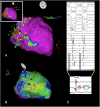Fascicular/Purkinje Tissue Colocalized With Scar in Cardiomyopathy Patients Undergoing Ventricular Fibrillation Ablation
- PMID: 40455574
- PMCID: PMC12266628
- DOI: 10.1111/pace.15215
Fascicular/Purkinje Tissue Colocalized With Scar in Cardiomyopathy Patients Undergoing Ventricular Fibrillation Ablation
Abstract
Background: Ventricular fibrillation (VF) is a poorly understood arrhythmia that is one of the main mechanisms of sudden cardiac death in patients with structural heart disease (SHD). Fascicular and Purkinje tissue (FPT) has been implicated in VF.
Objective: In this study, we sought to analyze the involvement of FPT colocalized with the scar area of SHD. Additionally, we aimed to investigate outcomes of FPT and scar substrate ablation in SHD VF patients and compare outcomes with VT ablation patients.
Methods: This is a retrospective observational study. Clinical and procedural data were collected.
Results: Sixteen patients undergoing VF ablation were assigned to the VF group, and their outcomes were compared to those of 170 patients who underwent structural VT ablation. In 15 patients, FPT targets colocalized with low voltage area, LPs, and/or LAVAs. Septal Purkinje and left posterior fascicle were most commonly involved. Procedural metrics were similar with patients undergoing VT ablation. During median follow-up of 5.5 months (interquartile range [IQR]: 3.5-10), VF recurred in two patients.
Conclusion: This study has shown frequent colocalization of FPT with electrophysiologic substrate (late potentials [LPs], low voltage area, etc.) in patients with SHD and VF. We have shown the feasibility of FTP and substrate ablation with good mid-term outcomes in a small group of patients. Larger studies are necessary for definitive evidence.
Keywords: Purkinje; catheter ablation; ventricular fibrillation.
© 2025 The Author(s). Pacing and Clinical Electrophysiology published by Wiley Periodicals LLC.
Conflict of interest statement
The authors declare no conflicts of interest.
Figures



References
Publication types
MeSH terms
LinkOut - more resources
Full Text Sources
Medical

